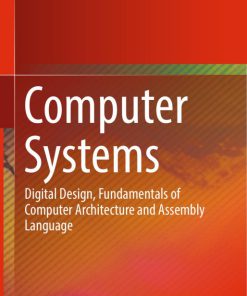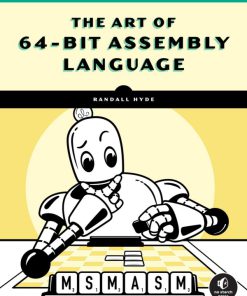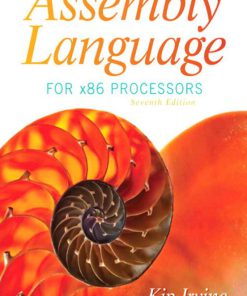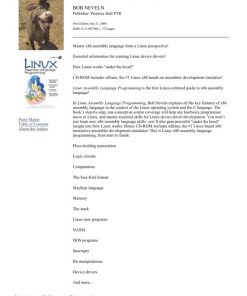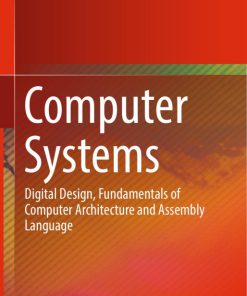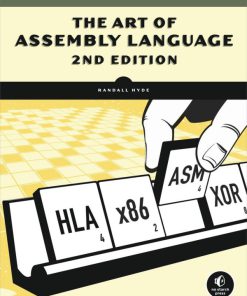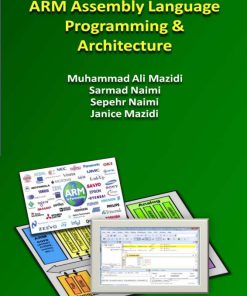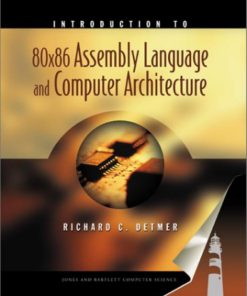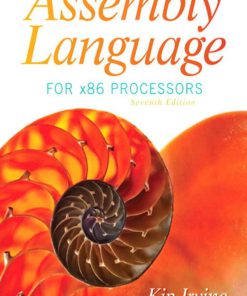Introduction To 80 86 Assembly Language And Computer Architecture 1st Edition by Detmer ISBN 0763717738 9780763717735
$50.00 Original price was: $50.00.$25.00Current price is: $25.00.
Authors:Richard C. Detmer , Series:Computer Science [318] , Author sort:Detmer, Richard C. , Ids:0763717738 , Languages:Languages:eng , Publisher:Jones and Bartlett Publishers , Comments:Comments:Published 2001, 499 pages.
Introduction To 80×86 Assembly Language And Computer Architecture 1st Edition by Detmer – Ebook PDF Instant Download/Delivery. 0763717738, 9780763717735
Full download Introduction To 80×86 Assembly Language And Computer Architecture 1st Edition after payment

Product details:
ISBN 10: 0763717738
ISBN 13: 9780763717735
Author: Detmer
A computer can be viewed from many different levels, and used for many different functions, such as the creation of new application software. However, an actual computer works at an even lower level than this. Introduction to 80×86 Assembly Language and Computer Architecture divides its emphasis between the assembly-language/machine-language level of computer operations and the architectural level, that is, the level defined by the machine instructions that the processor can execute. Although the primary architecture covered is the Intel 80×86 family, each chapter does include information about other architectures, or computer levels. Programmers are expected to program effectively at any level, therefore, Introduction to 80×86 Assembly Language and Computer Architecture is essential to the fundamental principles at the machine level that they will have to understand. Programming in assembly language and studying related concepts in Introduction to 80×86 Assembly Language and Computer Architecture prepares the student to program effectively in any programming language, to pursue advanced studies in computer design and architecture, and to learn more about system detail for specific computers.
Introduction To 80×86 Assembly Language And Computer Architecture 1st Table of contents:
-
Introduction to 80×86 Assembly Language and Computer Architecture
- 1.1 Overview of Assembly Language and Computer Architecture
- 1.2 The Role of 80×86 Architecture in Computing History
- 1.3 The Relationship Between Hardware and Software
- 1.4 Importance of Assembly Language Programming
-
Understanding the 80×86 Family of Processors
- 2.1 Evolution of the 80×86 Architecture
- 2.2 Key Features of the 80×86 Microprocessor Family
- 2.3 Differences Between 16-bit, 32-bit, and 64-bit Architectures
- 2.4 Registers, Flags, and the ALU (Arithmetic Logic Unit)
-
Basic Concepts in Assembly Language Programming
- 3.1 Syntax and Structure of Assembly Language
- 3.2 Instruction Set Architecture (ISA)
- 3.3 Machine Code and Assembly Instructions
- 3.4 Assembly Language vs High-Level Languages
-
The 80×86 Instruction Set
- 4.1 Categories of 80×86 Instructions: Data Movement, Arithmetic, Control Flow, etc.
- 4.2 General-Purpose Registers and Their Usage
- 4.3 Addressing Modes in 80×86 Assembly
- 4.4 Writing Basic Assembly Programs: Example Instructions and Syntax
-
The 80×86 Processor and Memory Organization
- 5.1 CPU Architecture and Execution Cycle
- 5.2 Memory Segmentation and Addressing
- 5.3 Stack and Stack Operations
- 5.4 Memory Models: Real Mode vs Protected Mode
-
Control Flow and Looping
- 6.1 Conditional Branching and Jump Instructions
- 6.2 Loops and Iteration in Assembly Language
- 6.3 Implementing Subroutines and Function Calls
- 6.4 Interrupts and Handling I/O Operations
-
Working with Data in 80×86 Assembly
- 7.1 Data Representation: Binary, Hexadecimal, and ASCII
- 7.2 Constants, Variables, and Immediate Values
- 7.3 Storing and Retrieving Data from Memory
- 7.4 Performing Arithmetic and Logical Operations
-
Advanced Assembly Techniques
- 8.1 Using 32-bit and 64-bit Registers
- 8.2 Floating-Point Arithmetic and Special Registers
- 8.3 Implementing Efficient Algorithms in Assembly
- 8.4 Optimizing Assembly Code for Performance
-
Interrupts and System Calls
- 9.1 Understanding Hardware Interrupts and Software Interrupts
- 9.2 The Role of Interrupt Vector Tables
- 9.3 System Calls and Interaction with the Operating System
- 9.4 Writing and Handling Interrupts in Assembly Language
-
Input/Output Operations
- 10.1 I/O Ports and Addressing
- 10.2 Using Assembly for Keyboard and Display I/O
- 10.3 Interfacing with External Devices via I/O Instructions
- 10.4 File Handling in Assembly Language
-
Using Debuggers and Development Tools
- 11.1 Introduction to Debugging Assembly Programs
- 11.2 Using Emulators and Simulators
- 11.3 Introduction to IDEs and Assembly Language Compilers
- 11.4 Efficient Troubleshooting and Code Optimization
-
The 80×86 Architecture in Modern Systems
- 12.1 Transition from 16-bit to 64-bit Architecture
- 12.2 Legacy Support in Modern CPUs
- 12.3 Role of 80×86 Architecture in Current Computing Systems
- 12.4 Comparison of 80×86 with Other Architectures (ARM, MIPS, etc.)
-
Practical Examples and Case Studies
- 13.1 Writing a Simple Assembly Program
- 13.2 Real-World Applications of Assembly Language
- 13.3 Performance and Efficiency in Real-Time Systems
- 13.4 Case Study: Booting a System Using 80×86 Assembly
People also search for Introduction To 80×86 Assembly Language And Computer Architecture 1st:
introduction to 80×86 assembly language
introduction to 80×86 assembly language and computer architecture
introduction to 80×86 assembly language and computer architecture pdf
introduction to 80×86 assembly language and computer architecture 3rd edition
intro to 80×86 assembly language
You may also like…
eBook PDF
Assembly Language for X86 Processors 7th edition by Kip Irvine ISBN 0133769402 978-0133769401
eBook PDF
Linux Assembly Language Programming 1st Edition by Bob Neveln ISBN 0130879401 9780130879400
eBook PDF
Assembly Language for x86 Processors 7th Edition by Kip Irvine ISBN 0133769402 9780133769401




